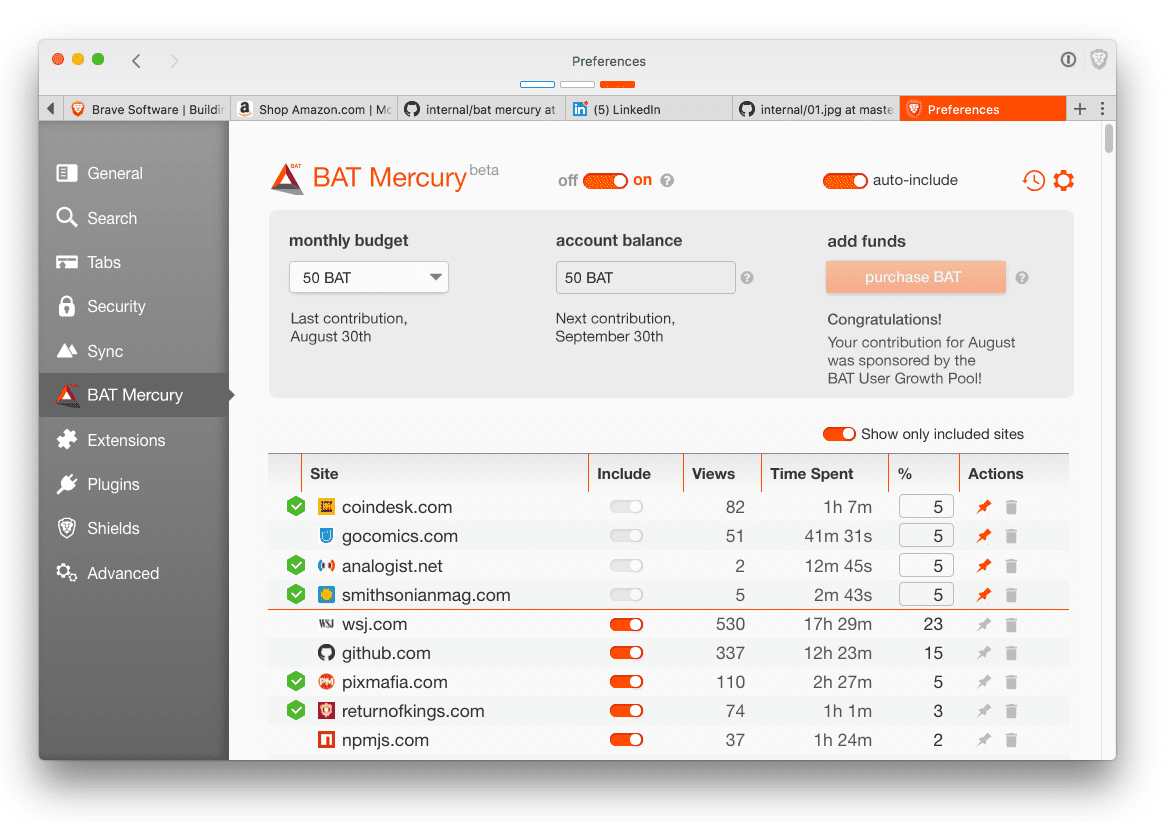Today we announce our launch plans for the first phase of the Basic Attention Token platform, code-named Mercury. The initial outline for Mercury was included in our roadmap announcement and the design concept is available on Github. BAT Mercury will be rolled out incrementally.
The Brave browser will be the first application on the BAT platform. The Brave browser currently allows users to make micro-contributions to publishers through the use of a Bitcoin wallet and ledger system. The launch of Mercury is targeted for mid-September and will include the replacement of the Bitcoin wallet integrated into the browser with a BAT wallet.
Browser User Onboarding (with in-browser BAT wallet creation)
BAT Mercury will utilize a portion of the 300 million BAT retained in the user growth pool. Users who enable BAT Mercury within the Brave browser will have their wallets automatically funded. At launch, the BAT wallet will be restricted from sending to addresses other than our settlement address; users will not be able to transfer BAT out of their in-browser wallet. The BAT flow in the browser will allow publishers to begin experimenting with reward models to spur patronage of their sites and services. A subsequent update will allow users to fund their BAT wallet similarly to how they are able to fund their Bitcoin wallet.
Another future update will give users the option of going through a “Know Your Customer” (KYC) process in order to gain full control over their BAT wallet, including the ability to transfer BAT out of the wallet.
Development of Basic Attention Metrics (BAMs), and In-Browser Analytics to View Measured Browsing Attention.

The BAT Mercury interface will appear familiar to users who have enabled the current Bitcoin-based Brave Payments beta. BAT Mercury features the granular fine-tuning contribution options and advanced settings from the current Bitcoin (but to be replaced with BAT) Brave Payments beta, including monthly publisher contributions that are either pro-rata or “pinned,” i.e., a pre-set amount.
There are two notable differences in the BAT Mercury interface:
- The monthly budget and account balance are now denominated in BAT.
- The purchase BAT button will remain inactive for the initial launch, as the BAT awarded from the user growth pool will initiate the one-way contribution flow at no cost to the user. However, with the multi-directional wallet update planned in later phases, the purchase BAT button will be reactivated
Browser Operations Related to User Contributions

BAT Mercury contribution algorithms will be retained from the Brave Payments beta. Measured attention from the active browser tab is distributed across the list of visited domains. Pinned contributions will be supported too, as in Brave Payments beta today.
Every 30 days the browser will attempt to send user contributions to the publishers. Anonymous BAT contributions will be automatically transferred from the user’s wallet to a contribution settlement account using Anonize2 Zero-Knowledge Proof protocols.
Aside from the denomination units being BAT, the contribution summary and statements for BAT Mercury are the same as in the Brave Payments beta.
Publisher Onboarding and Verification
The BAT Platform publisher onboarding and verification process will remain largely unchanged from the existing Brave solution. An interested publisher will perform two levels of verification:
- The publisher enters contact information, including an email address. They will then receive an email containing a validation URL. Since the URL contains a random secret, a visit by the publisher demonstrates that they can receive email at the address they provided.
- After visiting the validation URL, the publisher will be redirected to prove domain ownership. A publisher can either perform DNS validation by setting a TXT record or uploading a file to a specific address on their web site.
After verification, publishers will go through a slightly modified process to finish onboarding for BAT Mercury.
In the Brave Payments beta, the publisher entered a Bitcoin address to receive contributions, and completed a form indicating their US tax-filing status. This latter information was used for reporting compliance (Brave is required to file a 1099-MISC for US individuals and limited-liability corporations), and served as the “Know Your Customer” process for the publisher.
In BAT Mercury, instead of asking for a Bitcoin (or ETH) address the publisher is redirected to a third-party financial services platform:

The platform supports BAT, fiat currencies (such as USD, EUR, GBP, etc.), and other crypto currencies. The platform also provides US ACH and wire transfer services for fiat currencies. We have already reached agreement with the platform that will provide these services and will soon announce the details of this partnership.
BAT Mercury will offer automatic conversion of BAT and direct deposit of fiat currency into a publisher’s account. This allows us to offer a contribution settlement process that is more familiar to publishers, increasing the likelihood of adoption. As part of publisher onboarding by the platform, they will authorize the disclosure of the ETH address of the account and set their preferred fiat currency.
The BAT team will provide additional information as it becomes available. For the latest information, please track our #announcements channel in discord.gg/batbrigade.
Note: The term (and terms related to) “BAT Mercury” in this post’s text and screenshots are Brave Software International internal project names , not branded product names, and as such the nomenclature may change as the product matures. Consult the roadmap for a high-level description of all currently planned phases of BAT integration.
